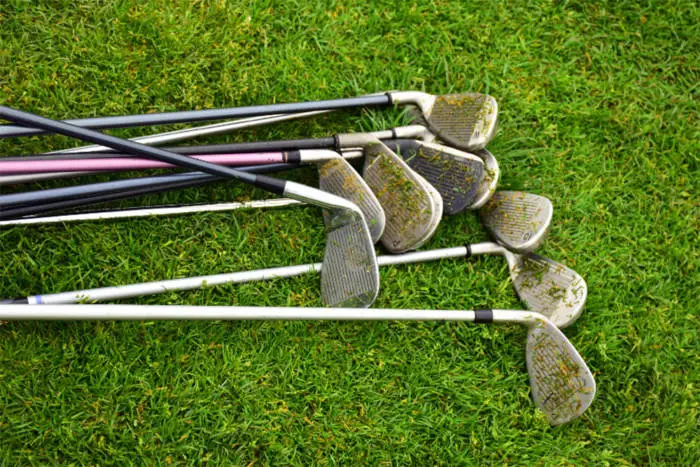How To Regrip Golf Clubs
A worn out golf grip will affect your game if they offer very little grip. The regular exposure to heat, dirt and oils constantly break down the materials in your golf grips making them less effective, especially when it comes to playing in wet conditions.
When your golf grips are becoming tattered, you can take your clubs to your local pro and pay anything between £55 – £120 ($75 – $150) to regrip a set of irons. However you might be curious to know that you can save money by doing this (relatively easy) by yourself at home.
In this article, we’ll provide you with a step-by-step guide on how to regrip golf clubs. So, next time your golf clubs are hindering your performance due to a lack of grip, you’ll know exactly how to fix it.

Replacing your golf grips is a relatively simple process once you know how, and you only need minimal equipment and a bit of DIY experience to carry out this project.
Equipment that you will need
- A small, sharp knife such as a Stanley knife
- New golf grips
- Grip tape or double sided tape
- A solvent such as White Spirit
- A clean cloth
How to regrip golf clubs
1. Remove the old grips
When it comes to applying new grips, the first step is to remove the old grips from your set of clubs.
You’ll need to carefully peel or cut the old grips off the golf club, making sure that you are being as safe as possible by cutting away from you.
The material of your clubs will determine how careful you need to be in this step. If your clubs are made out of steel, you don’t need to be so worried. However, if your cubs are made out of graphite on the other hand, then you should take more caution as they are easier to damage.
Peel off the old grip and scrape any excess tape away. This might take a little while, so you can always remove the remaining residue with grip solvent and a clean cloth. The solvent should speed up the process significantly!
2. Apply the grip tape
You will need to size up the new grip to determine how much of the shaft requires taping. This will save you from wasting tape!
Next, you’ll need to apply ¾” grip tape or a strong double sided tape in a spiral pattern from the top of the shaft to the point where the grip will end. Apply 2” grip tape lengthwise, also.
Following this, remove the paper backing from the tape. You’ll also need to add a little extra tape to the end of the shaft to ensure that the new grip sticks nicely to it when you come to apply the new grip to the metal shaft.
3. Add solvent
Next, you’ll need to add a solvent such as White Spirit to the inside of the grip. Grab a golf tee or another object that you have on hand and use it to plug the hole at the end of the new grip.
Pour solvent into the open end of the grip. Cover the open end with your hand and shake to distribute the solvent, so that the whole of the inside of the grip is coated.
You should place a tray under the clamped shaft to catch the excess solvent that you don’t use for this club. If you are regripping more than one club, you can use the excess solvent on the other clubs later on. After all, waste not want not.
4. Fit the new grips
While the grip tape is still wet, roughly align the grip with the club head and pull it down over the butt end of the shaft of the golf club that you are regripping.
You’ll need to make sure that any alignment tweaks are done quickly as there is a limited window in which you’ll be able to manoeuvre the grip. This is an important step, as you don’t want to be in a position where you need to replace the grip because it doesn’t feel right on the club!
Bearing this in mind, you should always ensure that the end of the shaft nestles onto the very end of the grip too.
5. Repeat the process for your other clubs
Carry out the same process for all of the clubs until all of your golf clubs are fitted with new grips. It’s as easy as that!
Once all of the clubs have been covered in new grips, the only thing left to do is to take them for a spin on the golf course!
Notes on regripping golf clubs

If you’d prefer to steer clear of the toxic chemicals, you don’t actually have to use traditional grip solvents. There are also environmentally friendly solvent alternatives such as soapy water and compressed air.
The big difference of using an alternative to a solvent is in drying times. The solvent-based approach requires about two hours of drying time, whereas the water-based alternative will require a minimum of 24 hours of drying time.
However, if you’re adamant about not wanting to use solvents in this process, then you might not mind about the longer drying time of using a water-based alternative.
How often should you change golf club grips?
Whether you play a number of times a week or a couple of times each month, ideally you should look to replace your golf grips at least once per year.
This is because golf grips are made of material that age and wear over time, regardless of how often they are used. After a year there is enough degradation in the grips where feel is lost and the grips become harder and glazed over.
Granted, if you play more than 40 rounds per year, you may need to replace your grips more often, but as a rule of thumb, once per year is fine.
Changing your golf club grips at the start of every new golf season in spring is the easiest way to remember to do this.
Is it worth regripping golf clubs?
Golf grips are the only point of contact between the golf club and the player, so are a crucial piece of golf equipment. Fresh grips can make a huge difference to your performance and confidence on the course.
If you’re using new grips, the tackiness of the grips allows you to hold the club losely which promotes good swing mechanics. However with older worn grips, there’s a tendancy to grip the club more tightly which can lead to tension in the arms and bad habits to creep into your technique.
As golf grips break down slowly over time, many golfers fail to notice the difference between fresh grips and old grips. However, a small slip in your hands at contact due to worn grips can be magnified to a number of yards by the time your ball reaches the intended target.
There are three signs of a worn grip to look out for:
- Slick grips – A slick, glossy appearance to the grip is the most obvious sign of worn grips
- Grip wear – If you have multi-compound grips with different colours, discolouration or the disappearance of paint is another obvious sign of worn grips
- Crumbling – Crumbling of the rubber or cord in the grip is another sign you need to replace them
How do you clean golf grips?
Once you replace your grips, you’ll want to keep them clean.
While black grips often disguise how dirty grips can get from frequent use on the golf course, you will need to be much more vigilant in terms of cleaning if you have opted for brightly colored grips.
Even if your grips don’t look dirty, you will need to clean your golf grips on a regular basis to sanitize them and keep them looking smart and fresh. After all, you don’t want all of your hard work to go to waste and it isn’t very hygienic to be playing with dirty grips, either!
To achieve this, there are a variety of different cleaning methods that golfers find convenient. We recommend that you use grip cleaning wipes or opt for a large bucket of warm water. You’ll need to dip a soft-bristled brush for corded or rubber grips and a washcloth for softer grips.